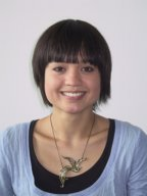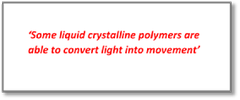 The responsiveness of liquid materials makes them ideal candidates for the design and development of smart materials, with potential applications in soft robotics and sensing. In this thesis the use of photo-responsive liquid crystals is studied. ‘The photo-switching of these doped materials occurs at the nano-scale but can be amplified up to the macroscale, resulting in the modification of their optical and mechanical properties,’ Sarah Jane Asshoff says. ‘Also we fabricated liquid crystalline microspheres and photo-controlled their reflective properties. Seeing these colourful microspheres change their patterns under the polarizing optical microscope, is very beautiful.’
The responsiveness of liquid materials makes them ideal candidates for the design and development of smart materials, with potential applications in soft robotics and sensing. In this thesis the use of photo-responsive liquid crystals is studied. ‘The photo-switching of these doped materials occurs at the nano-scale but can be amplified up to the macroscale, resulting in the modification of their optical and mechanical properties,’ Sarah Jane Asshoff says. ‘Also we fabricated liquid crystalline microspheres and photo-controlled their reflective properties. Seeing these colourful microspheres change their patterns under the polarizing optical microscope, is very beautiful.’
Three main aspects of smart materials were worked on by Sarah Jane in her PhD project. First of all, complex switchable properties were designed in order to enhance the possible use of unique properties of liquid crystals in future tools. Different material responses to light were investigated, such as changes in reflectivity and color polarization.
chirality

‘A second aspect involved chirality on different length scales that occur in a special type of liquid crystals,’ Sarah Jane says. ‘Some liquid crystalline polymers are able to convert light into movement. We managed to design a initially achiral flat structure that opens up in two helically shaped halves under the influence of a UV-light signal. Some of our other materials contain chiral molecules, or form chiral supramolecular structures that can be observed under the microscope.’

Sarah Jane further broadened her scope by studying, in the third phase of her research, liquid chrystal polymer films doped with super-paramagnetic nanoparticles. ‘This can lead to the formation of, so-called, soft magnets, to be possibly used in next generation storage devices. My PhD-project was fundamental in nature involving innovative experimental work: designing, fabricating, analyzing and characterizing various materials properties. Optical spectroscopy and polarizing optical microscopy were among the most important techniques I used from our lab, at the Biomolecular Nanotechnology (BNT) Group.’
collaboration
Together with her supervisor, Dr. Nathaly Katsonis, Sarah Jane found several collaboration partners within Mesa+ as well as from other universities within Europe. Materials Science expertise and experimental know-how from the NeuroImaging Group, for example, were crucial to fabricate superparamagnetic nanoparticles. For the preparation of liquid crystalline microspheres, the help from the Microfluidics Group was indispensable. ‘On this new topic for our group the contact with Dr. Séverine Le Gac - to prepare the spheres on a micro chip - was very helpful. It is great being able to broaden your skills in new areas of research.’
Scientific research
Further collaborations were launched with universities in Groningen, Paris, Bordeaux, Trieste and Oxford. ‘When I started the PhD-project I couldn’t apprehend scientific research was so closely intertwined with carefully finding common grounds for collaboration, taking university politics into account and – on a more personal level – having to deal with failure and finding one’s own driving force again and again. This process really made me understand my personal motives, to continue my research and take it further. When you are really at the brink of understanding something new, it takes you away from everything: The focus of work is intense and satisfying.’

After her defense Sarah Jane will join the BNT-Group for one more year, working on a different class of liquid crystals. ‘After that I plan to find a job in industry, as I am opting for more security in daily life. I have become an interdisciplinary researcher. Originally a chemist, I have shifted more towards materials science. During the PhD project I also was also inspired by biology, for example in designing the polymerized films of photo-switchable liquid crystals, to mimic the opening of a chiral seed pod.’
